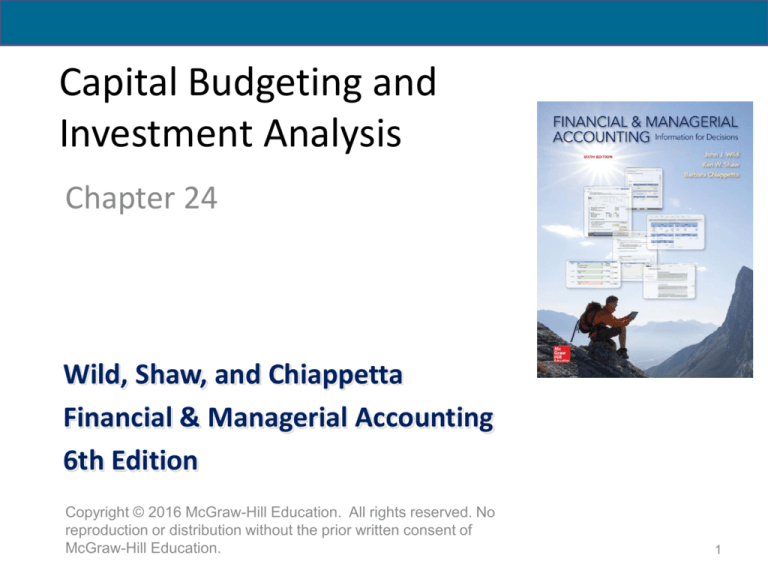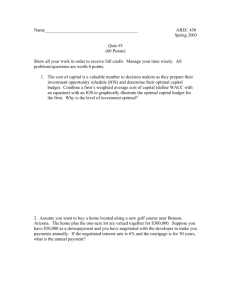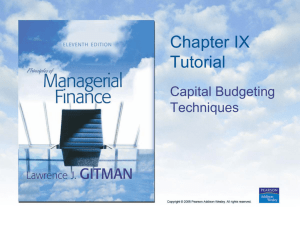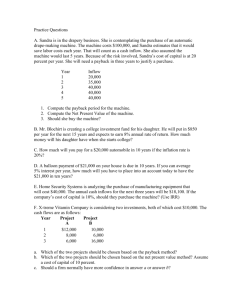
Capital Budgeting and
Investment Analysis
Chapter 24
Wild, Shaw, and Chiappetta
Financial & Managerial Accounting
6th Edition
Copyright © 2016 McGraw-Hill Education. All rights reserved. No
reproduction or distribution without the prior written consent of
McGraw-Hill Education.
1
Capital Budgeting
Capital budgeting is the process of analyzing alternative
long-term investments and deciding which assets
to acquire or sell.
Capital budgeting decisions require careful analysis because they are
usually the most difficult and risky decisions that managers make.
Specifically, a capital budgeting decision is risky because:
Outcome
is uncertain.
Decision may be
difficult or impossible
to reverse.
Large amounts of
money are usually
involved.
Investment involves a
long-term commitment.
2
24-P1:
Compute payback period and describe its
use.
3
P1
Payback Period
The payback period of an investment
is the expected amount of time it takes a
project to recover its initial investment amount.
Managers prefer investing in projects
with shorter payback periods.
4
P1
Computing Payback Period
with Even Cash Flows
Exhibit
24.2
Example: FasTrac is considering buying a new machine that will
be used in its manufacturing operations. The machine costs
$16,000 and is expected to produce annual net cash flows of
$4,100. The machine is expected to have an 8-year useful life
with no salvage value.
Calculate the payback period.
Payback
Cost of Investment
=
period
Annual Net Cash Flow
Payback
=
period
$16,000
$4,100
= 3.9 years
5
P1
Computing Payback Period
with Uneven Cash Flows
In the previous example, we assumed that the
increase in cash flows would be the same each
year. Now, let’s look at an example where the cash
flows vary each year.
$3,000
$4,000
$4,100
$5,000
6
P1
Computing Payback Period
with Uneven Cash Flows
Exhibit
24.3
FasTrac wants to install a machine that costs $16,000 and has an 8year useful life with zero salvage value. Annual net cash flows are:
To get the payback period when we have unequal annual net cash flows, we must
add the cash flows each year until the total equals the cost of the investment.
payback
period of
4.2 years
Payback
occurs
between
years 4 & 5
7
P1
Using the Payback Period
The payback period has two major shortcomings:
It ignores the time value of money; and
It ignores cash flows after the payback period.
Consider the following example where both projects
cost $5,000 and have five-year useful lives:
Year
1
2
3
4
5
Project One
Net Cash
Inflows
$
2,000
2,000
2,000
2,000
2,000
Project Two
Net Cash
Inflows
$
1,000
1,000
1,000
1,000
1,000,000
Would you invest in Project One over Project Two just
because it has a shorter payback period?
8
Need to Know 24.1
P1
A company is considering purchasing equipment costing $75,000. Future annual net cash
flows from this equipment are $30,000, $25,000, $15,000, $10,000, and $5,000. Cash
flows occur uniformly during the year. What is this investment's payback period?
Period
Year 0
Year 1
Year 2
Year 3
Year 4
Year 5
Expected Net Cash Flows
($75,000)
30,000
25,000
15,000
10,000
5,000
Cumulative Net Cash Flows
($75,000)
(45,000)
(20,000)
(5,000)
5,000
10,000
Payback between the end of Year 3 and the end of Year 4
Fraction of Year:
Absolute Value Cumulative Cash Flows Beginning of Year $5,000
Expected Net Cash Flows During Year
$10,000
0.5
Payback = 3.5 years
9
24-P2:
Compute accounting rate of return and
explain its use.
10
P2
Accounting Rate of Return
Two Ways to Calculate Average Annual Investment
When comparing investments with similar lives
and risk, a company will prefer the investment
with the higher accounting rate of return.
11
P2
Accounting Rate of Return
Exhibit
24.6
Let’s revisit the $16,000 investment being considered by FasTrac.
The new machine has an annual after-tax net income of $2,100.
Compute the accounting rate of return.
Annual Average Investment Calculation:
Beginning book value ($16,000) + Ending book value ($0) = $8,000
2
Accounting
rate of return
=
$2,100
$8,000
=
26.25%
12
P2
Accounting Rate of Return
Limitations
An asset's net income may
vary from year to year.
The accounting rate of
return ignores the time
value of money.
13
Need to Know 24.2
P2
The following data relate to a company’s decision on whether to purchase a machine:
Cost
$180,000
Salvage value
15,000
Annual after-tax net income
40,000
Assume net cash flows occur uniformly over each year and the company uses straight-line
depreciation. What is the machine's accounting rate of return?
The Accounting Rate of Return (ARR) measures the amount of net income generated
from a capital investment.
Accounting Rate of Return =
Annual After-Tax Net Income
Annual Average Investment
Annual After-Tax Net Income
(Cost + Salvage) / 2
$40,000
($180,000 + $15,000) / 2
$40,000
$97,500
41%
14
24-P3:
Compute net present value and describe
its use.
15
P3
Net Present Value
Net present value analysis applies the time value of
money to future cash inflows and cash outflows so
management can evaluate a project’s benefits and costs
at one point in time.
We calculate Net Present Value (NPV) by:
Discount the future net cash flows from the
investment at the required rate of return.
Subtract the initial amount invested from
sum of the discounted cash flows.
A company’s required rate of return, often called its hurdle rate, is
typically its cost of capital, which is the rate the company must pay to
its long-term creditors and shareholders.
16
P3
Net Present Value
with Equal Cash Flows
Exhibit
24.7
Example: FasTrac is considering the purchase of a machine costing
$16,000, with an 8-year useful life and zero salvage value, that
promises annual net cash inflows of $4,100. FasTrac requires a 12
percent annual return on its investments.
Exhibit 24.7
17
P3
Net Present Value Decision Rule
When an asset's expected future cash flows yield a positive
net present value when discounted at the required rate of
return, the asset should be acquired.
When comparing several investment opportunities
of similar cost and risk, we prefer the one with the
highest positive net present value.
18
P3
Net Present Value
with Uneven Cash Flows
Exhibit
24.8
Net present value analysis can also be applied when net
cash flows are uneven (unequal).
Exhibit 24.8
Although all projects require the same investment and have
the same total net cash flows, Project B has a higher net present
value because of a larger net cash flow in Year 1.
19
Need to Know 24.3
P3
A company can invest in only one of two projects, A or B. Each project requires a $20,000
investment and is expected to generate end-of-period, annual cash flows as follows:
Year 1
$12,000
4,500
Project A
Project B
Net Cash Inflows
Year 2
Year 3
$8,500
$4,000
8,500
13,000
Total
$24,500
26,000
Assuming a discount rate of 10%, which project has the higher net present value?
Project A
Year 1
Year 2
Year 3
Net Cash
Inflows
$12,000
8,500
4,000
$24,500
PV of Net Cash Inflows
Amount invested
Net Present Value – Project A
PV of $1 at
10%
0.9091
0.8264
0.7513
PV of Net
Cash
Inflows
$10,909
7,024
3,005
$20,939
$20,939
(20,000)
$939
20
Need to Know 24.3
P3
A company can invest in only one of two projects, A or B. Each project requires a $20,000
investment and is expected to generate end-of-period, annual cash flows as follows:
Year 1
$12,000
4,500
Project A
Project B
Project B
Year 1
Year 2
Year 3
Net Cash
Inflows
$4,500
8,500
13,000
$26,000
PV of Net Cash Inflows
Amount invested
Net Present Value – Project B
Net Cash Inflows
Year 2
Year 3
$8,500
$4,000
8,500
13,000
PV of $1 at
10%
0.9091
0.8264
0.7513
$20,882
(20,000)
$882
Total
$24,500
26,000
PV of Net
Cash
Inflows
$4,091
7,024
9,767
$20,882
PV of Net Cash Inflows
Amount invested
Net Present Value – Project A
$20,939
(20,000)
$939
Project A has the higher net present value.
21
24-P4:
Compute internal rate of return and
explain its use.
22
P4
Internal Rate of Return (IRR)
The interest rate that makes . . .
Present
Initial
value of - investment = $0
cash inflows
The net present value equals zero.
23
P4
Internal Rate of Return (IRR)
Projects with even annual cash flows
Example:
Project life = 3 years
Initial cost = $12,000
Annual net cash inflows = $5,000
Determine the IRR for this project.
Step 1. Compute present value factor for the investment project.
$12,000 ÷ $5,000 per year = 2.4000
Step 2. Identify the discount rate (IRR) yielding the present value
factor.
24
P4
Internal Rate of Return (IRR)
Step 1. Compute present value factor for the investment project.
$12,000 ÷ $5,000 per year = 2.4000
Step 2. Identify the discount rate (IRR) yielding the present value factor.
IRR is
approximately
12%.
25
P4
Internal Rate of Return (IRR)
Uneven Cash Flows
If cash inflows are unequal, it is best to use either a calculator or
spreadsheet software to compute the IRR. However, we can
also use trial and error to compute the IRR.
Use of Internal Rate of Return
When we use the IRR to evaluate a project, we compare the
internal rate of return on a project to a predetermined hurdle
rate (cost of capital). To be acceptable, a project’s rate of
return cannot be less than the company’s cost of capital.
26
Need to Know 24.4
P4
A machine costing $58,880 is expected to generate net cash flows of $8,000 per year for each of the next 10 years.
1. Compute the machine’s internal rate of return (IRR).
2. If a company’s hurdle rate is 6.5%, use IRR to determine whether the company should purchase this machine.
Internal rate of return (IRR) is the interest rate at which the net present value cash flows from a project or
investment equal zero.
PV of Net Cash Inflows
Amount invested
Net Present Value
$58,880
(58,880)
$0
PV of Net Cash Inflows = Annual Amount x PV Annuity of $1 factor
$58,880
= $8,000 x PV of Annuity of $1 factor
$58,880
$8,000
= PV of Annuity of $1 factor
7.3600
= PV of Annuity of $1 factor
IRR is approximately 6%.
Since this rate is lower than the 6.5% hurdle rate, the machine should not be purchased.
27
P4
Comparing Capital
Budgeting Methods
Exhibit
24.10
28
24-A1:
Analyze a capital investment project using
break-even time.
29
A1
Break-Even Time
Break-even time incorporates time value
of money into the payback period method
of evaluating capital investments.
It tells us the number of years an investment
requires for its net present value to equal its initial cost.
Cash
Flows
Break even
time for this
investment is
between 5
and 6 years.
30
End of Chapter 24
31







